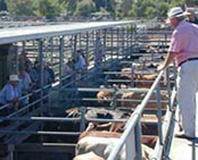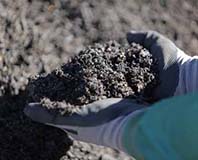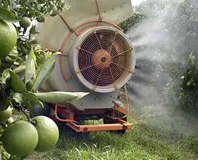Material Flow Beef Cattle Inputs Outputs

Feed
There is a high potential for diseases, pests and weeds to be carried in feed and water supplies. To protect the wellness of your livestock or crops information technology is important to minimise the risks associated with feed and water.
Purchasing feed
Ensure all feed purchased is free from unwanted weeds, soil and pests.
- Always request a Commodity Vendor Declaration (CVD) and ensure whatever feed you purchase is fit for purpose.
- Ensure you lot know the expiry date of any feed you purchase and use it before that date or dispose of it safely.
- Inspect feed to ensure that it does not contain a high ratio of weed seeds that could propagate on the property.
Feed storage
Poor feed storage encourages pests and diseases which may contaminate feed or reduce its usefulness. Onetime feed tin harbour illness organisms and pests that may be harmful to your livestock.
- Keep feed in a clean, dry out storage area.
- Proceed feed stores covered to forbid feed from becoming wet and mouldy.
- Regularly inspect feed supplies to ensure they remain secured and fit for purpose.
- Clean feed troughs regularly to avoid faecal contagion
- Dispose of onetime or contaminated feed safely, keeping it away from livestock and securing information technology from pests and diseases.
- Clean whatsoever feed spills promptly to foreclose spread around the property by air current or other ways (vehicle wheels, habiliment etc.)

Restricted animal material
Feeding restricted creature material (RAM) to ruminants is illegal in Commonwealth of australia every bit it is linked to the spread of bovine spongiform encephalopathy (BSE or Mad Moo-cow affliction)
- Practice non feed RAM to ruminants at all.
- Be aware of all materials on the restricted listing.
- Always bank check the labels of any feed purchased and ensure it is fit for purpose. Shop feed that contains RAM separately from feed that is appropriate for ruminants.
- Ensure all staff are aware of the RAM ban.
- Prevent visitors or passers-by from feeding livestock.
- Ever enquire for a Commodity Vendor Declaration that states the feed is gratis of RAM and chemical/physical contaminants.
Swill feeding
Swill feeding is a dangerous do which has led to the spread of diseases such every bit pes and mouth disease (FMD) in many countries and is illegal in Commonwealth of australia. Swill can be broadly defined as fabric of mammal origin or whatever substance that has come up in contact with this material.
- Do not feed pigs swill of any kind.
- Ensure all staff are aware swill feeding is illegal.
- Forestall visitors orpassers-by from feeding livestock.
More information almost feeding your pigs
Water supply and storage
Many pests and diseases tin survive for a long time in water until they find another host, then it is important to ensure water remains uncontaminated.
- In add-on, diseases, pests and weed seeds are easily distributed by flowing water.
- Regularly inspect water sources and ensure they are secured from access by wild/feral animals.
- Go on water troughs high enough to minimise contamination past animal faeces.
- Clean water troughs regularly to forestall build up of contaminants.
- Cover water sources where possible to prevent faecal contamination past wildlife.
- Don't allow water to stagnate every bit information technology may attract insects and other pests that can spread disease.
- Regularly inspect whatsoever water storage tanks to ensure they have not been compromised by wild/feral animals or chemically contaminated.
- Ensure weed seeds and pests cannot proceeds access to secure areas of the property through water distribution channels.
- Bank check areas effectually waterways for new weeds.
- Increase monitoring for new weeds later on flooding

Recycled water
Recycled h2o can come from roof run-off, stormwater, agricultural effluent (e.1000. dairy sheds or piggeries), irrigation run-off, or wastewater from food processing and wineries.
The quality of recycled water is divers using a class rating system, usually from A to D. Course A water is produced using high levels of treatment and is generally suitable for utilize on irrigated pastures, fruit, vegetables and wine grapes. Class D water is suitable for irrigating non-food crops, such every bit turf or plantations.
The A-D nomenclature arrangement is based on treatments to destroy microbes. It does not consider other contaminants, such as salt, chemicals or nutrients, which tin can also touch the health of plants and livestock.
- Follow all legal requirements in relation to the reuse of wastewater reuse.
- Use signs and lable taps to warn others most the apply of recycled water.
- Use imperial coloured piping or tape, the universal standard for recycled h2o.
- Make sure pumps etc are secure and access to them is restricted.
- Avoid over irrigating and creating runoff.
- Use drip irrigation for recycled water where possible to avoid aerosol formation
- Avert contamination of marketable produce.
- Proceed records of treatments, procedures and irrigation regimes.
- Observe withholding periods for fodder crops. The withholding period depends on the treatment the wastewater has received and the type of use.
- Brand sure livestock cannot drink from puddle water contaminated with wastewater or from wastewater storage dams.
- Warn employees to avoid exposure to waste material h2o, to wash their hands and remove boots etc afterwards contact.
- Preclude algal blooms past aerating or treating water that is loftier in nutrients and is stored in dams.
- Prevent young and vulnerable stock from grazing pastures irrigated with recycled effluent for the 'withholding period' after each irrigation.
- Use filtration, UV radiation or chlorination to treat h2o to foreclose the spread of plant diseases in recycled drainage water.
New animals, plants and other inputs
New animals entering the holding
Animals tin can conduct diseases and pests without necessarily showing any signs, so it is important to manage the introduction of new animals advisedly to avert infecting the balance of your stock. Treating individual animals is cheaper and easier than managing a new disease in all stock on your property. Manage new and returning stock in a like manner.
- Always asking a National Vendor Declaration (NVD) and brute health statementand whatsoever other records of the stock's health status.
- Keep a record of where the livestock have come from. This may involve uploading information to the NLIS database as well.
- Buy stock from a trusted source and audit them before you buy.
- Be aware of the cleaning and hygiene practices of the ship provider/south.
- Inspect stock on inflow to make sure they are salubrious and in the aforementioned condition as when you purchased them; seek advice from a vet if necessary.
- Isolate new stock for a period of 21 days to allow any signs of affliction to emerge, and to permit time for weed seeds to be excreted by the animals. Monitor and manage these areas for new pests and diseases.
- When taking animals to shows and sales, think that your stock tin exist exposed to disease past mixing with other animals or coming into contact with contaminated pens, vehicles, people and equipment.

Growing media and establish containers
Pests and contamination can be hands brought onto your holding with production nursery inputs and plant material. Ensure propagation textile is 'make clean' (ie tested with no pest detections) and where possible, use simply certified production nursery inputs. To minimise the take chances:
- cheque your propagation material and production nursery inputs thoroughly
- maintain a register of all production nursery inputs entering your holding, including its source (with contact details), specific planting or storage locations, numbers of plants or other products, and the date of use
- request information on the source of material and testing timetable.
Find out about BioSecure HACCP for production nurseries.

Fertiliser
Reduce the risk of purchasing contaminated or not-compliant fertiliser by ensuring that the supplier is post-obit the Fertilizer Industry Federation of Australia (FIFA) Purchasing Code of Practice or has equivalent quality controls in identify.
Organic fertiliser can carry weed seeds and diseases. Ensure that beast manure and green waste is aged and thoroughly composted to destroy weed seeds and diseases. Maintain a record of sources of organic fertilisers, delivery and application dates etc.
Farm chemicals
Chemical residues can result in produce being rejected from export and domestic markets. In addition, nigh institute produce ends up being used as human food, even when fed to livestock, and then inappropriate apply or awarding of pesticides can pose a risk to man health, particularly through the presence of chemical residues.
- Ensure your staff has had advisable training and advice on the safe utilize of pesticides (for example ChemCert® or SMARTtrain).
- Always follow characterization instructions (dilution and application rates, expiry date, disposal of residues).
- Keep a spray diary of herbicide, pesticide and fumigation treatments for crops and attach to withholding periods.
- Check details nearly regulations for agronomical and veterinary chemicals. These tin exist found through the Australian Pesticides and Veterinary Medicines Say-so (APVMA) or from relevant state agencies. (Consult these sources frequently for data regarding chemical regulations as regulations may be updated regularly.)
Mis-employ of many types of chemicals can lead to the development of resistance to pests, potentially creating new biosecurity risks and direction challenges.

Source: https://www.farmbiosecurity.com.au/essentials-toolkit/farm-inputs/

Post a Comment for "Material Flow Beef Cattle Inputs Outputs"